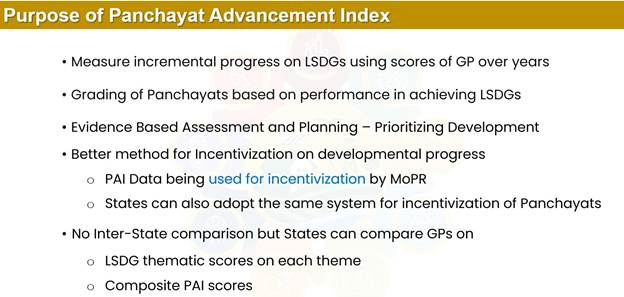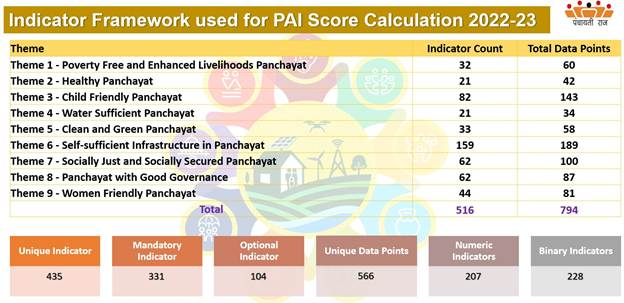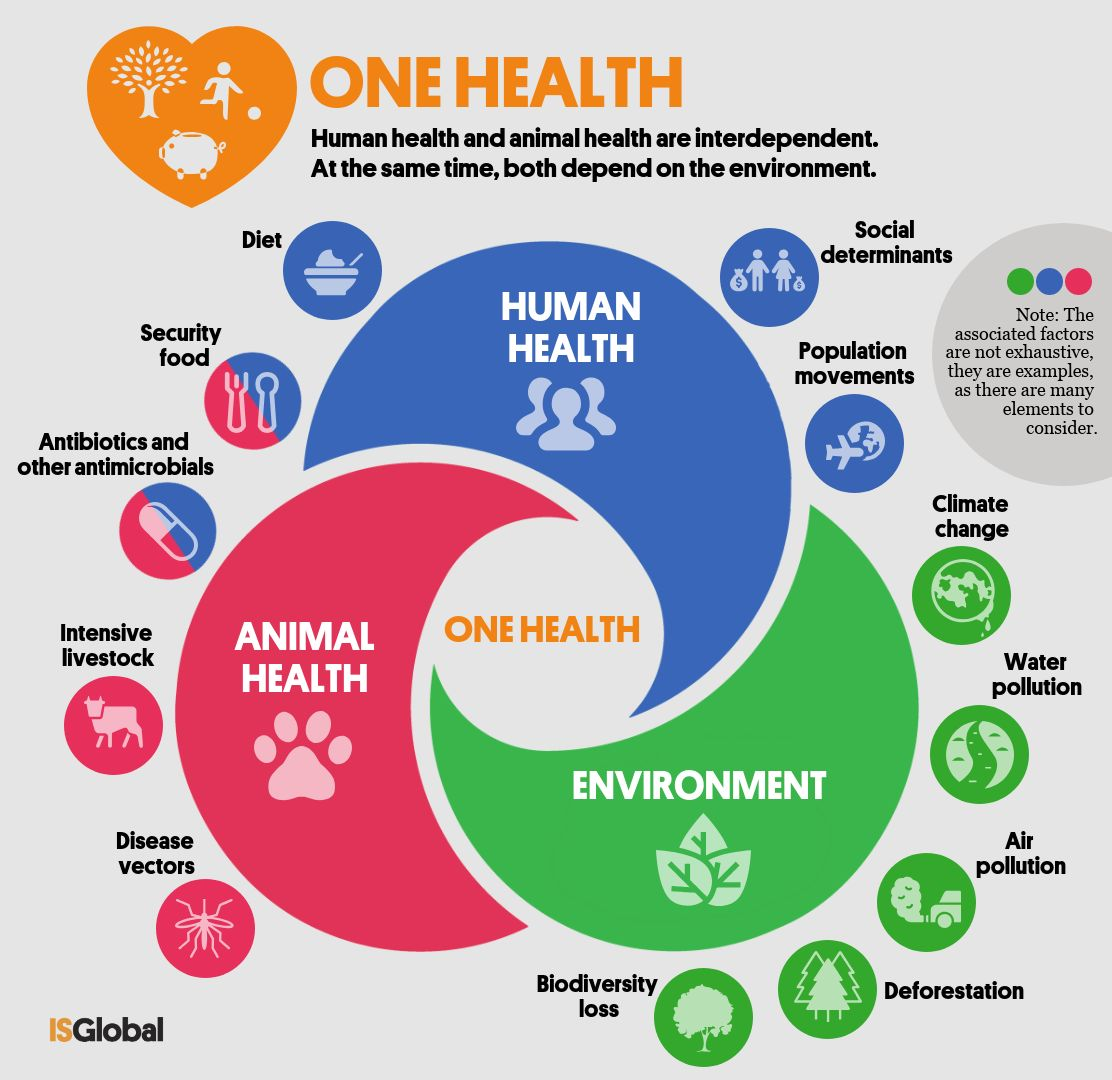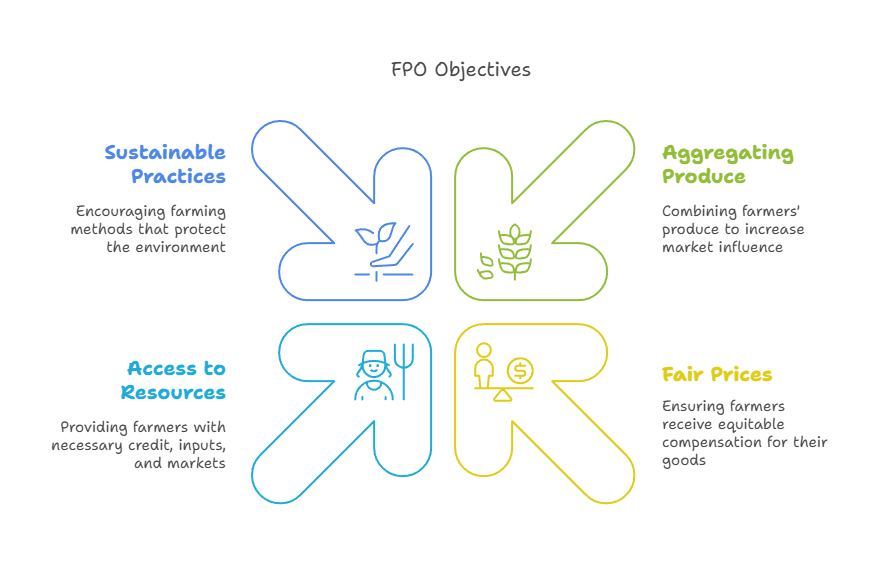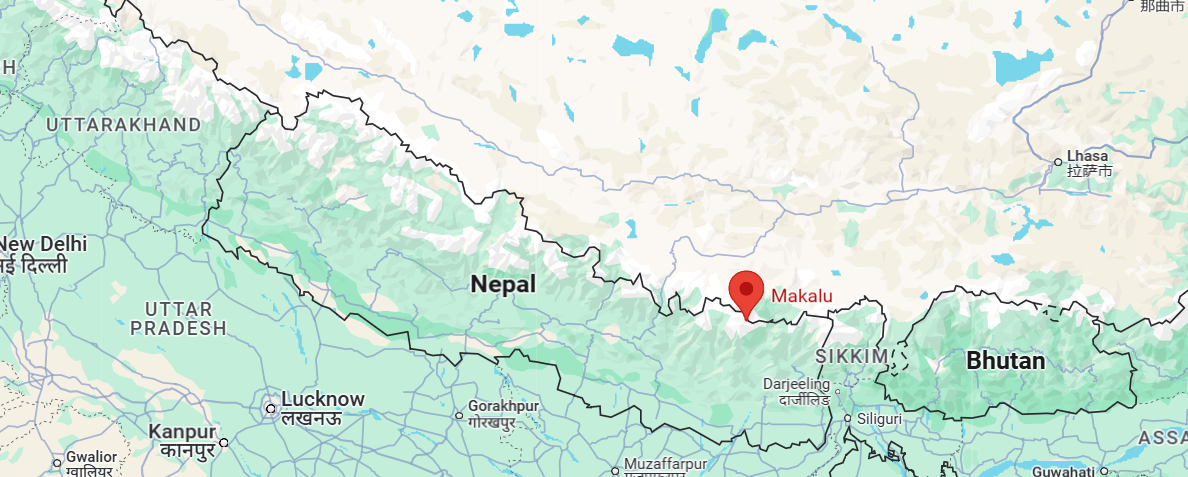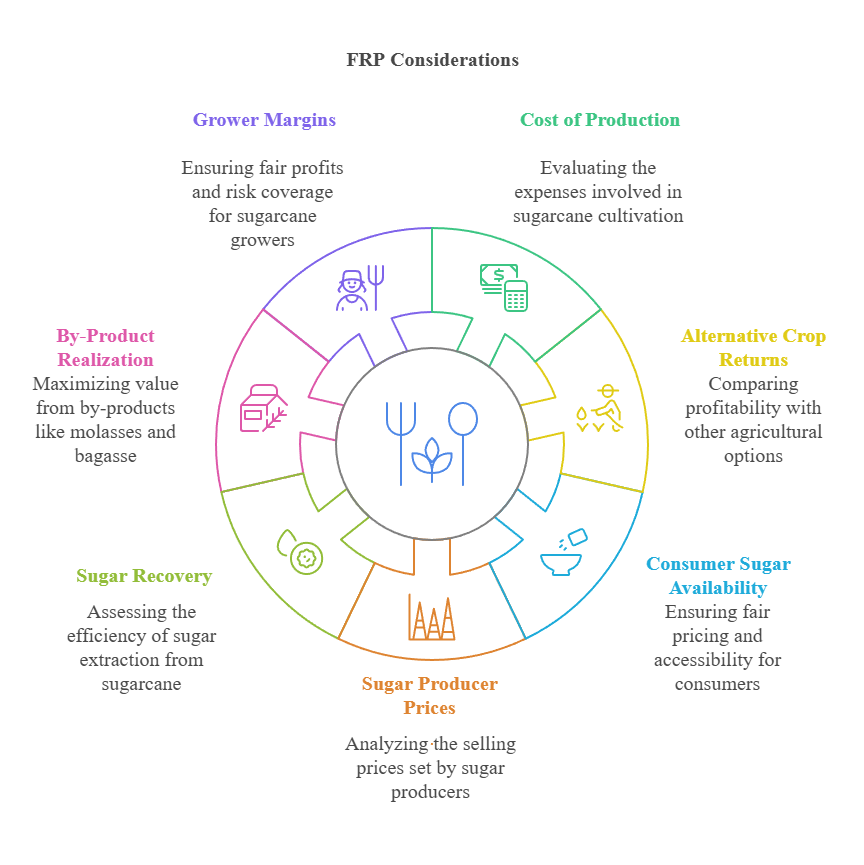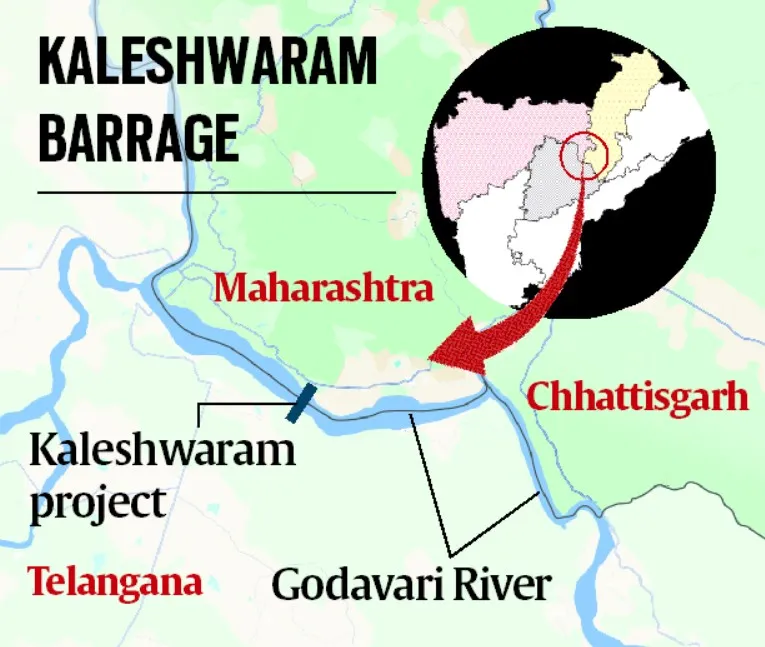Governance
Panchayat Advancement Index
For Prelims: Panchayat Advancement Index (PAI), National Panchayati Raj Day, National Indicator Framework, 73rd Constitutional Amendment Act, Geographic Information System
For Mains: Financial empowerment of PRI, Issues in Panchayati Raj Institutions, Sustainable Development Goals
Why in News?
Prime Minister Narendra Modi, on National Panchayati Raj Day (24th April), highlighted the Panchayat Advancement Index (PAI) as a key step toward empowering local governance and achieving Viksit Bharat 2047 by ranking 2.16 lakh panchayats on Sustainable Development Goals (SDGs) linked themes.
What is the Panchayat Advancement Index?
- About: PAI is a composite index designed to assess the performance and progress of Gram Panchayats (GPs) across India using socio-economic indicators, identifies development gaps, and supports evidence-based planning.
- It aligns with the Localization of Sustainable Development Goals (LSDGs) and the National Indicator Framework (NIF) developed by the Ministry of Statistics and Programme Implementation (MoSPI).
- It reflects India’s commitment to the SDG 2030 Agenda by promoting participatory, bottom-up governance, assessing GPs development through socio-economic indicators, identifying gaps, and enabling evidence-based planning.
- Indicators of the PAI: It is based on 435 unique local indicators across 9 LSDG-aligned themes.
- It is designed to provide a multi-domain and multi-sectoral assessment of Panchayat-level development.
- Data Collection and Validation: Over 2.16 lakh GPs from 29 States/Union territories (UTs) have entered data on the PAI Portal. Data entries are validated by respective States/UTs before inclusion.
- Performance Categories of GPs: Based on their PAI and thematic scores, GPs are classified into five performance categories: Achiever (90+), Front Runner (75–89.99), Performer (60–74.99), Aspirant (40–59.99), and Beginners (below 40).
- PAI data for 2022-23: Out of 2.56 lakh GPs, 2.16 lakh submitted validated data. No Panchayat qualified as an Achiever, while 0.3% were classified as Front Runners, 35.8% as Performers, 61.2% as Aspirants, and 2.7% as Beginners.
Constitutional Provisions Regarding PRIs
- 73rd Amendment Act, 1992: It granted constitutional status to PRIs, creating a three-tier system with provisions for elections, reservations, and devolution of powers across gram sabhas, panchayat samitis, and zila parishads.
- Part IX of the Constitution, added through the 73rd Amendment Act, 1992 and titled "The Panchayats," comprises Articles 243 to 243-O and lays down the structure, composition, elections, powers, and functions of PRIs.
- The 11th Schedule, also added by the same amendment, lists 29 subjects devolved to Panchayats, detailing their powers, authority, and responsibilities for effective local governance.
- Article 40 (Directive Principles of State Policy): It directs the State to organize village panchayats and empower them appropriately..
What are the Challenges Facing Panchayats?
- Limited Financial Autonomy: Panchayats rely heavily on state and central funds. According to an Reserve Bank of India study (2022-23), average revenue per Panchayat was Rs 21.23 lakh, but only 1.1% came from their own revenue sources (local taxes, fees).
- The 15th Finance Commission (2021–26) noted that only 8 states had constituted their 6th State Finance Commission (SFC), despite the due date being 2019–20. This continues to hinder the development and empowerment of Panchayats.
- Additionally, Local tax collection remains politically sensitive and administratively weak in GPs.
- Incomplete Devolution: The 73rd Constitutional Amendment Act, 1992 mandates the devolution of 29 subjects to Panchayati Raj Institutions (PRIs), but a 2022 Ministry of Panchayati Raj report revealed that less than 20% of states have fully implemented this transfer.
- Technological and Capacity Gaps: Lack of digital infrastructure and literacy hampers monitoring, evaluation, and data reporting.
- 12 states/UTs have 100% computer-equipped panchayats, but Arunachal Pradesh has none, and Odisha has only 13%. Internet access is also poor, with Haryana and Arunachal Pradesh reporting 0% and 1% connectivity, respectively.
- Many panchayats lack trained staff and technical advisors to design, monitor, and evaluate development plans.
- Inadequate Infrastructure: Only 7 states and UTs have 100% pucca (permanent) panchayat office buildings.
- Arunachal Pradesh has the lowest rate, with only 5% of its panchayat offices housed in pucca structures.
- Representation Gaps: Despite a 50% quota for women in panchayats, states like Madhya Pradesh, Haryana, Punjab, and Tripura fall short.
- Women make up 46.6% of elected representatives, but their participation is limited due to the "Pradhan Pati" issue, where male relatives often control decision-making.
- Patriarchal norms and bureaucratic neglect reduce women to figureheads in many states, particularly in northern regions like UP, Bihar, Haryana, and Rajasthan.
- Poor Inter-Departmental Coordination: Multiple government departments often function independently within the same village. Lack of convergence leads to duplication of work and inefficient resource use.
What Measures can Enhance the Effectiveness and Autonomy of Panchayati Raj Institutions (PRIs)?
- Ensure Financial Autonomy: States must effectively implement Article 243-I, forming a State Finance Commission every five years to assess finances and recommend tax distribution and suggest measures to improve Panchayats' financial health.
- Aligning with the L.M. Singhvi Committee (1986), which called for more financial resources for Panchayats, the adoption of RBI’s 2022 report on automated tax mapping via Geographic Information System (GIS) can significantly enhance tax collection at the Panchayat level.
- Devolution and Empowerment: States must adhere to the spirit of 73rd Constitutional Amendment by devolving the 29 subjects in the Eleventh Schedule effectively. Ensure timely and untied fund transfers to enable need-based planning.
- Boost Institutional Capacity: Enhance the Rashtriya Gram Swaraj Abhiyan (RGSA) to strengthen PRI capacity through targeted training for women and marginalised representatives.
- Promote convergence with Self-Help Groups (SHGs) and Community-Based Organisations (CBOs) to deepen community participation and local accountability.
- Technological and Data-Driven Governance: Integrate digital modules via BharatNet and Common Service Centres (CSCs) for continuous learning.
- Expand the usage of e-Gram Swaraj, which allows for digital planning, budgeting, and real-time monitoring of development works.
- Adopt a structured audit framework using the Local Government Directory (LGD) and performance tracking tools like the Mission Antyodaya dashboard.
- Encourage Scheme Convergence: Integrate key Central and State schemes like Mahatma Gandhi National Rural Employment Guarantee Scheme, Jal Jeevan Mission (JJM), and Swachh Bharat Mission (Grameen) through a unified, panchayat-level action plan.
- This approach enables need-based, locally tailored development instead of a one-size-fits-all model, ensuring greater relevance, efficiency, and impact at the grassroots level.
- Promote Gender Inclusion: Implement the recommendations of the 2013 Committee on the Status of Women in Panchayati Raj by establishing Women Resource Centres to support elected women representatives and address issues such as the ‘Sarpanch Pati’ phenomenon.
- Institutionalise gender budgeting and include disaggregated gender data in Gram Panchayat Development Plans (GPDPs).
|
Drishti Mains Question: Discuss the systemic barriers faced by Panchayati Raj Institutions in India and suggest reforms for empowering them as agents of grassroots development. |
UPSC Civil Services Examination, Previous Year Questions (PYQs)
Prelims
Q1. Local self-government can be best explained as an exercise in (2017)
(a) Federalism
(b) Democratic decentralisation
(c) Administrative delegation
(d) Direct democracy
Ans: (b)
Q. The fundamental object of Panchayati Raj system is to ensure which among the following? (2015)
- People’s participation in development
- Political accountability
- Democratic decentralisation
- Financial mobilisation
Select the correct answer using the code given below
(a) 1, 2 and 3 only
(b) 2 and 4 only
(c) 1 and 3 only
(d) 1, 2, 3 and 4
Ans: (c)
Mains
Q. To what extent, in your opinion, has the decentralisation of power in India changed the governance landscape at the grassroots? (2022)
Q. Assess the importance of the Panchayat system in India as a part of local government. Apart from government grants, what sources can the Panchayats look out for financing developmental projects? (2018)
Q. In absence of a well-educated and organised local level government system,`Panchayats’ and ‘Samitis’ have remained mainly political institutions and not effective instruments of governance. Critically discuss. (2015)


Governance
India’s Livestock Sector
For Prelims: 20th Livestock Census, Nutritional Security, Lumpy Skin disease, Gross Value Added, Veterinary services, Genetic Surveillance.
For Mains: Significance & Contribution of Livestock in the Indian Economy, Current Challenges Related to Livestock in India, One Health Approach.
Why in News?
India’s livestock sector is a backbone of rural livelihoods and nutrition, making animal health a national priority. As World Veterinary Day 2025 celebrated the theme “Animal Health Takes a Team,” it underscored the critical role of veterinarians and the growing need for a One Health approach in tackling zoonotic risks.
What is the State of the Livestock Sector in India?
- Livestock: India has the world’s largest livestock population and it is a key pillar of Indian agriculture, supporting rural livelihoods, nutrition, and economic growth.
- It involves rearing cattle, buffaloes, sheep, goats, pigs, and poultry for meat, milk, eggs, and wool.
- Key Livestock Data:
- As per the 20th Livestock Census (2019), India has a total livestock population of 535.78 million.
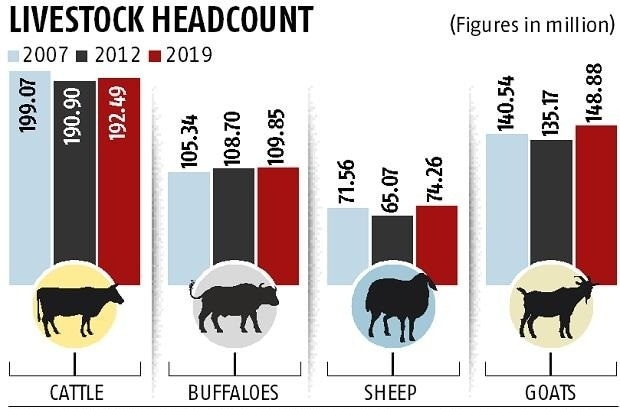
- Milk, Meat, and Egg Production: India ranks 1st in milk production, contributing 24.76% of global production.
- India ranks 2nd in egg production (1st China) and 5th in meat production globally (Food and Agriculture Organization, 2022).
What is the Significance of the Livestock Sector in India?
- Contribution to GDP: The livestock sector grew at a CAGR of 12.99% (2014-15 to 2022-23), contributing 5.50% of India’s Gross Value Added (GVA) in 2022-23.
- It also provides employment to about 8.8 % of the population in India.
- Nutritional Security: Livestock ensures food security by providing protein-rich products like milk, eggs, and meat. The dairy sector alone accounts for two-thirds of the total value of livestock output.
- Sustainability and Climate Resilience: Livestock supports sustainable farming by providing organic manure, improving soil fertility, and reducing chemical use. Integrated livestock-crop systems enhance resilience, especially in drought-prone areas.
- Exports and Foreign Exchange: Exports of livestock products, including buffalo meat, dairy, and poultry, rose by over 10%, reaching USD 3.64 billion during April-December 2024, strengthening India’s foreign exchange.
- Poverty Alleviation: Livestock is a key asset for poverty reduction, with over 50% of rural women engaged in livestock activities, contributing to income and financial independence.
- Cultural and Societal Importance: Livestock has cultural and religious significance, especially in festivals and rituals. In states like Rajasthan and Gujarat, it also reinforces community bonds and preserves traditional practices.
What are the Key Issues Associated with the Livestock Sector in India?
- Low Productivity: India’s livestock productivity, especially in dairy, meat, and poultry, remains low compared to global standards.
- For example, India's average annual cattle milk productivity in 2019-20 was 1,777 kg/animal, well below the global average of 2,699 kg (FAO, 2019)
- Inadequate Infrastructure The sector suffers from poor breed quality, inadequate feeding, lack of proper veterinary services, cold chain facilities, and modern slaughterhouses.
- This leads to high post-harvest losses, poor product quality, and limited market access for small farmers.
- Climate Risks & Environmental Impact: Climate change affects livestock productivity due to erratic weather, rising temperatures, and feed shortages.
- On the other hand, livestock farming itself contributes to methane emissions and contributes to soil degradation and biodiversity loss due to overgrazing practices.
- Health Risks Zoonotic diseases like avian influenza, foot-and-mouth disease (FMD), and brucellosis pose significant health threats.
- Around 60% of infectious diseases are zoonotic, and 75% of emerging infections are of animal origin.
- Poor hygiene, inadequate veterinary services, and lack of awareness increases the spread of such diseases.
- As per the data indicated by the Secretary of the Department of Animal Husbandry and Dairying (DAHD), India needs to produce 2500 additional veterinary graduates annually for the next five years to meet the growing demand.
- Lack of Adequate R&D: Lack of R&D in livestock genetics, nutrition, and disease control hampers progress and greater focus is needed on breed improvement, efficient feed systems, and veterinary advancements to boost sector performance.
What are the Key Initiatives to Strengthen the Livestock Sector?
- National Initiatives:
- Livestock Health and Disease Control (LHDC) Programme
- National Animal Disease Control Programme (NADCP)
- National Livestock Mission (NLM)
- Animal Health Security Strengthening in India for Pandemic Preparedness & Response: It is backed by FAO, ADB, and World Bank to support India’s animal health security by upgrading labs, improving surveillance, and training field vets for pandemic preparedness.
- International Collaborations:
- Food and Agriculture Organization (FAO): FAO has strengthened India’s veterinary services by standardizing treatment guidelines (2024).
- It has supported AMR management through the National Action Plan 2.0 and the Indian Network for Fisheries and Animal Antimicrobial Resistance (INFAAR).
- FAO has also trained veterinarians via the In-Service Applied Veterinary Epidemiology Training (ISAVET).
- Asian Development Bank (ADB) and the World Bank: They support India in enhancing animal health security by funding infrastructure, improving zoonotic disease surveillance, upgrading labs, and strengthening veterinary training for better pandemic response.
- Food and Agriculture Organization (FAO): FAO has strengthened India’s veterinary services by standardizing treatment guidelines (2024).
What Measures can be Adopted to Enhance Productivity and Sustainability of India's Livestock Sector?
- Breed Improvement and Nutrition Enhancement : Promote genetic upgradation through selective breeding and artificial insemination.
- Improve fodder management, develop region-specific feed formulations, and enhance pasture management to boost productivity and reduce overgrazing.
- Strengthen Veterinary Services: Strengthen veterinary care access, vaccination, disease surveillance, and early warning systems, supported by agencies like FAO, ADB, and World Bank.
- Provide incentives to veterinary doctors to serve in rural and underserved areas.
- Strengthening R&D and Technology Adoption: There is a need to increase investment in R&D for livestock genetics, climate-resilient practices, and disease control, while promoting reproductive technologies and sustainable farming practices.
- Improving Infrastructure and Market Linkages: Improve cold chains, storage facilities, and processing units. Strengthen farmer-producer organisations (FPOs) for better market access and fair pricing.
- Adopt One Health Approach: Integrate human, animal, and environmental health through cross-sector collaboration, strengthening surveillance and response systems to tackle zoonotic diseases and antimicrobial resistance.
What is the “One Health” Approach?
- About: The One Health approach is a collaborative, multisectoral, and transdisciplinary strategy that recognizes the interconnectedness of human, animal, and environmental health.
- It promotes integrated policies and programs aimed at preventing global pandemics and improving public health outcomes.
- Key Features:
- Holistic Perspective: Focuses on the shared environment, human-animal interactions, and ecosystem balance.
- Disease Prevention: Aims to reduce the risk of zoonoses like rabies, Ebola, avian influenza, Covid-19, and antimicrobial resistance (AMR).
- Long-term Planning: Encourages preventive health strategies rather than reactive responses.
- Historical Context & Institutional Initiatives:
- The One Health approach began in 1947 with WHO’s veterinary public health unit, inspired by James Steele’s “one medicine” concept, and is reflected in declarations like Alma-Ata (1978), Ottawa Charter (1986), and Shanghai Declaration (2016).
- WHO leads through the One Health Initiative Team and the quadripartite collaboration (WHO, FAO, OIE, UNEP), supporting countries with policy integration and early disease detection.
- The National One Health Mission is a comprehensive initiative in India aimed at strengthening the country's disease response and promoting a holistic approach to public health
Conclusion
The livestock sector plays a crucial role in India’s economy, rural livelihoods, and food security. Strategic initiatives, such as breed improvement, enhanced veterinary services, and the adoption of a One Health approach, are key to fostering sustainability and improving overall sector performance.
|
Drishti Mains Question: Discuss recent trends in livestock production in India and assess the impact of government initiatives on the sector. |
UPSC Civil Services Examination, Previous Year Questions (PYQs)
Prelims
Q. As per the NSSO 70th Round “Situation Assessment Survey of Agricultural Households”, consider the following statements: (2018)
- Rajasthan has the highest percentage share of agricultural households among its rural households.
- Out of the total agricultural households in the country, a little over 60 percent belong to OBCs.
- In Kerala, a little over 60 percent of agricultural households reported to have received maximum income from sources other than agricultural activities.
Which of the statements given above is/are correct?
(a) 2 and 3 only
(b) 2 only
(c) 1 and 3 only
(d) 1, 2 and 3
Ans: (c)
Mains
Q. Livestock rearing has a big potential for providing non-farm employment and income in rural areas. Discuss suggesting suitable measures to promote this sector in India. (2015)


Agriculture
Farmers Producer Organisation
For Prelims: Farmer Producer Organisations (FPOs), Small Farmers’ Agribusiness Consortium (SFAC), Cooperatives, e-NAM, Agri-tech Startups,
For Mains: Status, concerns and way forward for farmer producer organisations (FPOs).
Why in News?
The development of Farmer Producer Organizations (FPOs) has been a critical step towards empowering small farmers in India. Despite the government's significant investment in FPOs, their progress has been slower than anticipated.
What is a Farmers Producer Organisation?
- About: An FPO is a type of producer organisation (PO) with farmers as its members, and its promotion is supported by the Small Farmers’ Agribusiness Consortium (SFAC).
- The FPOs came into existence in 2008, inspired by economist YK Alagh’s recommendation (2002) to amend the Companies Act, 1956.
- FPOs can be registered under the Companies Act, 2013, the Societies Registration Act, 1860, or as Public Trusts under the Indian Trusts Act, 1882.
- A Producer Organisation is a group of producers, agricultural, non-farm, or artisan, that can take legal forms like producer companies or cooperatives, sharing profits among members.
- Objectives & Need: Indian agriculture is dominated by small and marginal farmers (87% owning less than 2 hectares), facing weather and market risks, and struggling to get fair prices.
- FPOs help small farmers by facilitating bulk input purchases, improving bargaining power, and ensuring better price realization with reduced costs.
- They also enhance market access, supporting the goal of doubling incomes and entering global markets.
- FPOs help small farmers by facilitating bulk input purchases, improving bargaining power, and ensuring better price realization with reduced costs.
- Current Status: 45,000 FPOs are registered as companies, but only 16,000 are compliant with regulatory filings.
- Just 4,000 FPOs have received working capital loans for procurement and average net profit per FPO is Rs 3 lakh (too low to significantly boost farmer incomes).
Success Story of FPOs
- Indian Successful Story:
- Kandhamal Apex Spices Association for Marketing (KASAM) in Odisha promotes Kandhamal turmeric through 61 Spice Development Societies.
- It collaborates with Kisan Saathi, helping Gumapadar FPC Ltd. export turmeric to NedSpice Group in the Netherlands, demonstrating FPOs' potential to reach global markets.
- Global Success Stories:
- Mexico (Ejido System): Ejidos are communal farming systems where land is collectively owned and managed by communities, helping farmers access international markets, particularly for crops like avocados and berries.
- Thailand: Programs like "One Tambon (Village) One Product" promote unique local agricultural products.
- China: Farmer Professional Cooperatives (FPCs) in sectors like tea, fruits, and aquaculture have reached global markets, with platforms like Alibaba enabling direct sales to consumers.
What are the Key Challenges Faced by FPOs in Indian Agriculture?
- No One Size Fits All Approach: FPOs cannot single-handedly resolve deep-rooted issues like the vulnerability of farmers to climate risks, the lack of robust rural infrastructure, the limited reach of Minimum Support Prices (MSP) for many crops, the volatility of global agricultural prices, and the persistent social inequalities that marginalize certain farming communities.
- Limited Impact in Market Linkages: Despite 3,500 FPOs being integrated with e-NAM, the traded value (Rs 3.19 lakh crore) is only a fraction of the total agricultural GVA (Rs 50 lakh crore at current prices).
- The disparity shows that e-NAM is not fully reaching the broader agricultural economy due to low adoption, market fragmentation, infrastructure gaps, and regional disparities.
- Thin Margins: Most FPOs operate on thin margins in input/output marketing (3-6%), raising doubts about long-term viability.
- With limited profit margins, FPOs may struggle to cover operational costs, invest in growth, and sustain their activities.
- Challenge of Replacing Middlemen: Farmers rely on middlemen for trust, credit, and payments. FPOs may not fully replace them, especially in regions with feudal systems, making complete elimination unrealistic.
- Mere Outsourcing Channels: Some FPOs act as procurement agents or custom hiring centers, diluting their original purpose of empowering farmers.
- Lack of Social Capital: FPOs need social capital and a gestation period to build consensus and thrive, as organizations based on social networks can't take root overnight.
- Without social capital, FPOs may face challenges in sustainability, governance, and growth, delaying benefits to farmers and hindering expansion.
How can FPOs be Strengthened for Sustainable Agriculture?
- Creating Iconic FPOs: Identify and support high-potential FPOs with capable leadership, active farmer participation, and viable business models.
- Partner with Civil Society Organizations (CSOs), philanthropies, and agri-tech startups to nurture these FPOs as model institutions for others to emulate.
- Develop Knowledge Resources: Create vernacular handbooks on FPO operations covering business models (input supply, marketing, value addition), financial management (profit-sharing, working capital), and digital tools (e-NAM, ONDC, agri-tech) for its smooth functioning.
- Build Local FPO Professionals: Train rural youth in FPO management through short-term courses at agricultural universities, and deploy them as FPO Promoters, self-employed professionals who help establish and manage FPOs for a fee.
- Encourage Value Addition: Support FPOs in processing, branding, and certification (e.g., organic, GI tags), facilitate direct retail partnerships (supermarkets, export markets), and promote FPO-led agri-tourism, farmer markets, and subscription-based models (e.g., weekly vegetable boxes).
Conclusion
FPOs hold significant potential to empower small farmers by improving market access and bargaining power. However, their success hinges on addressing challenges like thin margins, scalability, and trust-based relationships. Focusing on high-potential FPOs, leveraging digital platforms, and promoting value addition will be key to their long-term sustainability.
|
Drishti Mains Question: Analyze the challenges faced by FPOs and suggest how they can be made economically viable. |
UPSC Civil Services Examination Previous Year’s Question (PYQs)
Prelims
Q. With reference to ‘Urban Cooperative Banks’ in India, consider the following statements:
- They are supervised and regulated by local boards set up by the State Governments.
- They can issue equity shares and preference shares.
- They were brought under the purview of the Banking Regulation Act, 1949 through an Amendment in 1966.
Which of the statements given above is/are correct?
(a) 1 only
(b) 2 and 3 only
(c) 1 and 3 only
(d) 1, 2 and 3
Ans: (b)
Q. Consider the following statements: (2020)
- In terms of short-term credit delivery to the agriculture sector, District Central Cooperative
- Banks (DCCBs) deliver more credit in comparison to Scheduled Commercial Banks and Regional Rural Banks.
- One of the most important functions of DCCBs is to provide funds to the Primary Agricultural Credit Societies.
Which of the statements given above is/are correct?
(a) 1 only
(b) 2 only
(c) Both 1 and 2
(d) Neither 1 nor 2
Ans: (b)
Mains
Q. In the villages itself no form of credit organisation will be suitable except the cooperative society.” – All India Rural Credit Survey. Discuss this statement in the background of agricultural finance in India. What constraints and challenges do financial institutions supplying agricultural finance face? How can technology be used to better reach and serve rural clients? (2014)


Important Facts For Prelims
Pradhan Mantri Fasal Bima Yojana
Why in News?
According to the Ministry of Agriculture and Farmers Welfare, 97% of all reported claims under the Pradhan Mantri Fasal Bima Yojana (PMFBY) and the Restructured Weather-Based Crop Insurance Scheme (RWBCIS) have been settled across India.
- Goa, Chhattisgarh, Telangana, and Tamil Nadu have achieved full claim settlement, while Tripura, Andaman and Nicobar Islands, Andhra Pradesh, and Sikkim have settlement rates from 91% to 51%.
What is Pradhan Mantri Fasal Bima Yojana?
- About: Launched in 2016, PMFBY is a Central Sector Scheme designed to offer financial protection to farmers against crop losses caused by natural disasters, pests, or diseases.
- As of 2023–24, PMFBY became the world’s largest crop insurance scheme in terms of the number of farmers enrolled and land area covered.
- Key Features:
- Eligibility: All farmers including sharecroppers and tenant farmers growing the notified crops in the notified areas are eligible for coverage.
- Participation in PMFBY is voluntary, with non-loanee farmers comprising 55% of total beneficiaries.
- Risk Coverage:
- Natural Disasters: Includes floods, droughts, cyclones, hailstorms, landslides, and unseasonal rainfall.
- Pest & Disease Coverage: Protects against pest attacks and crop diseases.
- Post-Harvest Losses (Individual Farm Basis) : Compensation for damage within 14 days of harvest, especially for crops kept in "cut and spread" condition.
- Localised Calamities: The government provides compensation for localised calamities on an individual farm basis.
- Prevented Sowing (on Notified Area Basis): If most insured farmers in a notified area are unable to sow due to adverse weather despite intent and incurred costs, they can claim up to 25% of the sum insured as indemnity.
- Premium Rates: Farmers pay affordable premiums—2% for Kharif crops, 1.5% for Rabi crops, and 5% for annual commercial or horticultural crops.
- The government fully subsidizes premiums for farmers in the Northeast, Jammu & Kashmir, and Himachal Pradesh.
- Technological Integration:
- Satellite Imagery & Drones: Used for estimating crop area, resolving yield disputes, and assessing crop losses.
- Crop Cutting Experiments (CCEs): The CCE-Agri App enables direct data upload to the National Crop Insurance Portal (NCIP), ensuring transparent yield assessment.
- It also utilizes DigiClaim, Collection of Real Time Observations and Photographs of Crops (CROPIC), and Weather Information Network Data Systems (WINDS).
- Payouts: PMFBY aims to process claims within two months of harvest, offering timely financial support to prevent farmers from falling into debt traps.
- Eligibility: All farmers including sharecroppers and tenant farmers growing the notified crops in the notified areas are eligible for coverage.
Restructured Weather-Based Crop Insurance Scheme
|
UPSC Civil Services Examination Previous Year Question (PYQ)
Prelims
Q. With reference to ‘Pradhan Mantri Fasal Bima Yojana’, consider the following statements: (2016)
- Under this scheme, farmers will have to pay a uniform premium of two percent for any crop they cultivate in any season of the year.
- This scheme covers post-harvest losses arising out of cyclones and unseasonal rains.
Which of the statements given above is/are correct?
(a) 1 only
(b) 2 only
(c) Both 1 and 2
(d) Neither 1 nor 2
Ans: (b)


Rapid Fire
Genome-edited Rice Varieties
India has released its first genome-edited rice varieties namely 'DRR Dhan 100 (Kamala)' and 'Pusa DST Rice 1' aimed at enhancing yields, climate resilience, and resource efficiency without introducing foreign DNA.
- They have been developed by ICAR using advanced CRISPR-Cas9 genome-editing technology. No foreign DNA is introduced, making them comparable to traditionally bred crops.
- DRR Dhan 100 (Kamala): It is based on the popular Samba Mahsuri variety. Edited using Site Directed Nuclease 1 (SDN1) technology targeting the Cytokinin Oxidase 2 (CKX2) gene (Gn1a) to improve grain number.
- It results in early maturity (Harvested 15–20 days earlier), drought-tolerant, high nitrogen-use efficiency.
- Pusa DST Rice 1: It is based on Maruteru 1010 variety and enhances drought and salt tolerance. Developed through SDN1 genome-editing, it targets the drought and salt tolerance (DST) gene.
- It results in 30.4% higher yield in coastal salinity, 14.66% higher in alkaline soils and 9.67% higher in inland salinity.
- Site-Directed Nuclease Technology: It is a genome-editing technique that introduces precise changes in DNA using enzymes called nucleases.
- SDN-1 introduces small insertions/deletions without using foreign DNA, while SDN-2 uses a template DNA (similar to the host) to introduce specific desired changes.
| Read More: Climate Resilient Agriculture |


Place In News
Mt. Makalu
The Indo-Tibetan Border Police (ITBP) successfully scaled Mt. Makalu, the fifth highest peak in the world.
- Mt. Makalu: Resides in the Mahalangur range of the Nepal Himalayas, straddling the border between Nepal and Tibet, and is 8,485 meters above sea level.
- Located southeast of Mount Everest, Makalu is renowned for its striking pyramid shape with four sharp ridges.
- Mt. Makalu, located in Makalu Barun National Park, overlooks the scenic Barun Valley.
- Makalu also features two prominent subsidiary peaks, Makalu I and II, located about 3 km from the main summit. The Mt. Makalu was first ascended in 1955 by a French expedition led by Jean Franco.
- ITBP: The ITBP under the Ministry of Home Affairs, is a Central Armed Police Force specializing in high-altitude border guarding along the 3,488 km India-China border.
- ITBP has now climbed 6 of the world’s 14 ‘eight-thousanders’, and 229 peaks overall, including Mt. Everest, Mt. Kanchenjunga, Mt. Dhaulagiri, Mt. Lhotse, and Mt. Manaslu
| Read more: New Height for Mount Everest |


Rapid Fire
Increase in Fair and Remunerative Price
The Cabinet Committee on Economic Affairs (CCEA) increased the Fair and Remunerative Price (FRP) of sugarcane for the 2025-26 sugar season.
- About FRP: FRP is the minimum price at which sugar mills are legally required to purchase sugarcane from farmers in India.
- It is governed by the Sugarcane Control Order, 1966 issued under the Essential Commodities Act (ECA), 1955.
- Under the Sugarcane Control Order, 1966, payment must be made within 14 days of cane delivery; delays attract up to 15% interest, and unpaid FRP can be recovered by attaching mill properties.
- The FRP is based on the Rangarajan Committee report (2012) on reorganizing the sugarcane industry.
- Its determination is based on recommendations from the Commission for Agricultural Costs and Prices (CACP) and after consultations with State Governments and other stakeholders.
- CACP, under the Ministry of Agriculture and Farmers Welfare, is an advisory body with non-binding recommendations.
- Factors Considered in FRP:
| Read More: Fair and Remunerative Price (FRP) |


Rapid Fire
Kaleshwaram Lift Irrigation Project
The Kaleshwaram Lift Irrigation Project (KLIP) in Telangana is under scrutiny after the National Dam Safety Authority (NDSA) reported significant structural damage and design flaws in the project.
KLIP:
- KLIP is the world’s largest multi-stage lift irrigation project on the Godavari River, located in Bhupalpally district, Telangana.
- It spans over 500 km across 13 districts, with a canal network of 1,800 km.
- The construction of the project began in June 2019 and it aims to provide 240 TMC (Thousand Million Cubic feet) of water for various uses, with 70% earmarked for irrigation.
- The project starts at the confluence of the Pranhita and Godavari rivers.
- KLIP uses massive pump systems and surge pools to lift water to elevated delivery chambers for distribution across a vast command area.
River Godavari:
- Godavari, often called Dakshin Ganga, is India’s second-longest river (after Ganga), originating from Trimbakeshwar in Maharashtra.
- It flows 1,465 km eastward, draining in Maharashtra, Telangana, Andhra Pradesh, Chhattisgarh, and Odisha, before emptying into the Bay of Bengal.
- Major tributaries: Purna, Pranhita, Indravati, and Sabari (Left-Bank) and Pravara, Manjira, and Manair (Right Bank).
NDSA:
- NDSA is a statutory body headquartered in New Delhi, established under the National Dam Safety Act, 2021 to regulate and oversee dams, formulate policies, resolve disputes and conduct awareness programs.
| Read More: Kaleshwaram Lift Irrigation Project. |



